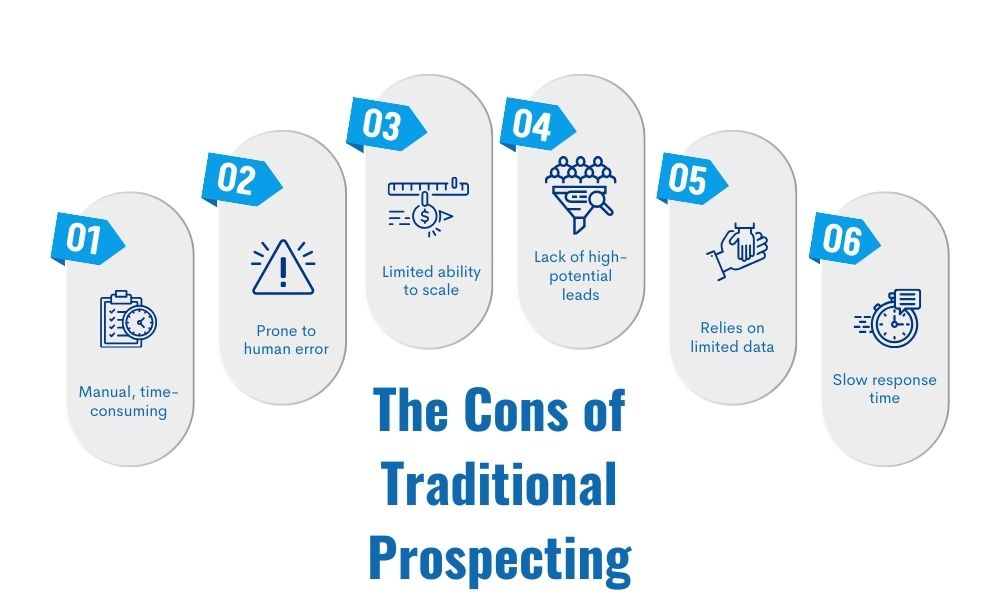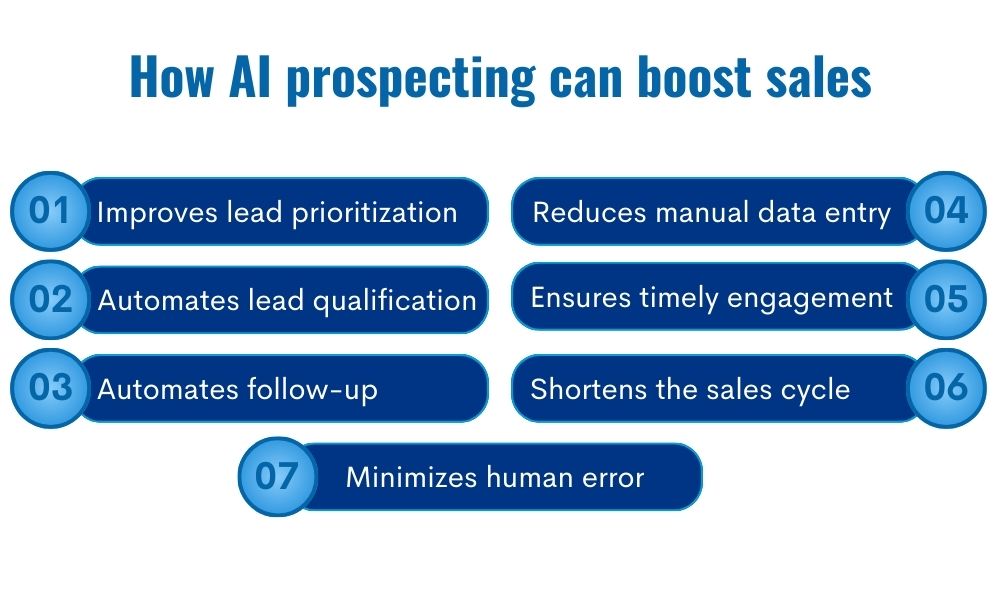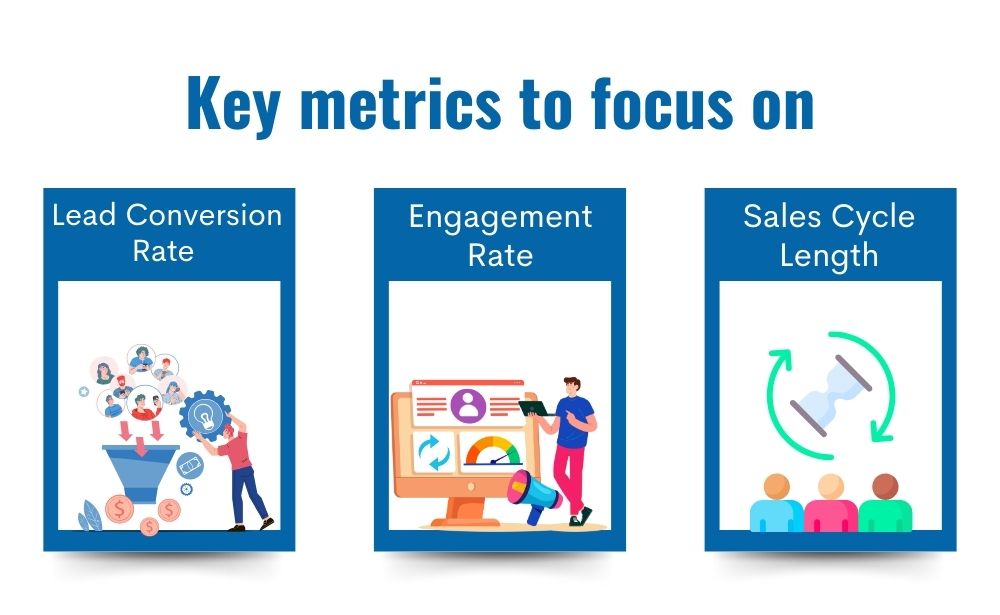The role of artificial intelligence (AI) in B2B sales has evolved from being a cutting-edge concept to becoming a core strategy for businesses seeking to streamline and enhance their lead engagement. As the b2B sales landscape becomes increasingly data-driven, AI for sales prospecting is transforming how companies identify, qualify, and nurture leads. It’s no longer enough to rely on manual prospecting processes; AI sales tools enable businesses to engage with leads more effectively and efficiently.
In this blog, we’ll explore the transformative impact of AI-powered sales prospecting and how businesses can leverage it to uncover new opportunities, automate outreach, and prioritize high-quality leads.
AI for Sales Prospecting: Uncovering Hidden Opportunities
For decades, sales teams have relied on traditional prospecting methods to generate leads. These methods typically involve manually researching potential prospects, analyzing their behaviors, and reaching out to them through cold calls or emails. However, this approach has its limitations: it’s slow, labor-intensive, and prone to human error. Sales teams often miss out on high-potential leads because of the time constraints and manual nature of the process.
AI sales prospecting offers a more efficient alternative by automating many of the manual tasks that sales teams used to handle. One of the key advantages of AI sales prospecting is its ability to uncover hidden opportunities that might otherwise go unnoticed. AI prospecting tools can sift through large volumes of data, including historical sales data, customer behavior patterns, and demographic information, to identify leads that align closely with a company’s ideal customer profile.
For example, AI can analyze past customer behaviors and purchase histories to predict which leads are most likely to convert. This enables sales teams to focus their efforts on the prospects with the highest potential, rather than wasting time on low-quality leads. AI’s ability to identify hidden patterns and trends helps businesses discover leads that would have been missed using traditional prospecting methods.
In addition, AI-powered tools can provide real-time insights into changes in a lead’s behavior, allowing sales teams to engage with prospects at the optimal moment. By identifying leads that are actively engaging with a company’s content or showing signs of interest, AI helps sales teams stay ahead of the competition.

Automating Outreach Without Losing the Human Touch
One of the common concerns about using AI for sales prospecting is that automated outreach may come across as impersonal. However, modern AI-powered sales prospecting tools are designed to balance automation with personalization, ensuring that each prospect feels like they’re receiving a tailored message.
AI tools can analyze a prospect’s past interactions with a brand, their behavior on the company’s website, and even their social media activity to craft personalized outreach messages. By automating the process of personalizing emails, AI enables businesses to engage with a larger volume of prospects while maintaining a high level of relevance in their communications.
This personalized automation allows sales teams to scale their outreach efforts without sacrificing the quality of engagement. While AI handles the repetitive tasks of crafting and sending personalized messages, sales reps can focus on building relationships and addressing more complex inquiries from high-potential leads.
Data-Driven Lead Prioritization: Focusing on What Matters Most
One of the most significant challenges in sales prospecting is deciding which leads to prioritize. With AI prospecting tools, businesses can take a data-driven approach to lead prioritization, ensuring that their sales teams are focusing on the prospects that are most likely to convert.
AI tools use predictive analytics to score leads based on their behavior, past interactions, and engagement with the company. This scoring system helps sales teams identify which leads are “hot” and which ones may require further nurturing. By analyzing vast datasets, AI can make real-time adjustments to lead scores, ensuring that sales teams are always working with the most up-to-date information.
By focusing on the most qualified leads, sales teams can allocate their time and resources more effectively, resulting in higher conversion rates and a more efficient sales process.
Increasing Sales Team Productivity with AI-Powered Tools
AI-powered prospecting tools not only help with lead identification and qualification but also free up time for sales teams by automating many of the repetitive tasks that typically slow them down. From scheduling follow-up emails to updating CRM systems, AI can take care of the mundane tasks, allowing sales reps to focus on what they do best: engaging with prospects and closing deals.
By automating these routine tasks, AI-powered sales prospecting tools can significantly boost sales team productivity. Instead of spending hours on administrative tasks, sales reps can focus on high-value activities that drive revenue. This increase in productivity can lead to shorter sales cycles and higher overall sales performance.
Moreover, AI reduces the risk of human error, ensuring that no lead is overlooked and that follow-up communications are sent at the optimal time. This consistency in prospect engagement can help businesses build stronger relationships with leads and move them through the sales funnel more effectively.

Real-Time Adaptation: AI’s Role in Dynamic Prospecting
The ability to adapt to real-time changes is a game-changer for businesses using AI for sales prospecting. AI prospecting tools can continuously update prospect information based on new data, ensuring that sales teams are always working with the most relevant insights.
For example, if a prospect suddenly shows increased engagement with a company’s website or interacts with a specific piece of content, AI can alert the sales team in real time. This allows sales reps to engage with the prospect at the right moment, increasing the likelihood of a successful conversion.
This real-time adaptability is one of the key advantages of using AI over traditional prospecting methods. Instead of relying on outdated information, sales teams can respond to changes in prospect behavior as they happen, improving the overall effectiveness of their outreach efforts.
Measuring Success: The Metrics that Matter in AI-Driven Prospecting
To measure the effectiveness of AI-driven sales prospecting, businesses should focus on key metrics like lead conversion rate, engagement rate, and sales cycle length.
- Lead conversion rate shows the percentage of leads turning into customers, with AI improving this by identifying high-quality prospects.
- Engagement rate tracks how actively prospects interact with outreach efforts, such as email open and response rates.
- Lastly, sales cycle length measures how quickly leads move through the funnel, which AI shortens by automating tasks.
AI tools provide real-time insights into these metrics, allowing businesses to make data-driven decisions and refine their strategies. Continuous tracking of these KPIs ensures maximum return on investment (ROI) by identifying areas for improvement and optimizing the sales process.

Conclusion
AI for sales prospecting is transforming the way businesses engage with leads, providing them with the tools they need to uncover hidden opportunities, automate outreach, and prioritize high-quality leads. By leveraging AI, sales teams can operate more efficiently, focusing on high-value tasks while allowing AI to handle the repetitive and time-consuming aspects of prospecting.
Platforms like GoMeet AI offer cutting-edge AI solutions that seamlessly integrate into existing sales strategies, helping businesses take their prospecting efforts to the next level and driving meaningful engagement with leads. Visit Gomeet AI for more information.

